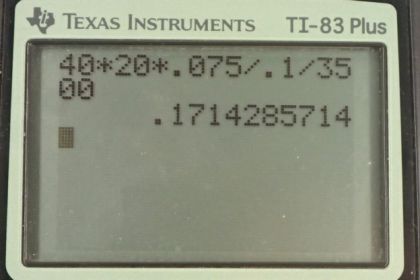Question
Rubbing your hands together warms them by converting work into thermal energy. If a woman rubs her hands back and forth for a total of 20 rubs, at a distance of 7.50 cm per rub, and with an average frictional force of 40.0 N, what is the temperature increase? The mass of tissues warmed is only 0.100 kg, mostly in the palms and fingers.
Final Answer
Solution video
OpenStax College Physics, Chapter 14, Problem 5 (Problems & Exercises)

vote with a rating of
votes with an average rating of
.
Calculator Screenshots
Video Transcript
This is College Physics Answers with Shaun Dychko. A woman is rubbing her hands together 20 times and the question is by how much will she increase the temperature of her palms? We're told that the mass of tissue that's going to be heated is only about 0.10 kilograms. And, the distance of each rub is seven and a half centimeters. We convert that into meters. The friction force that she's opposing is 40 Netwons and this distance of friction, force are needed because that's going to be the work done on the hands. That work is going to be turned into thermal energy. And so, that's going to be the heat transferred into her palms. That's going to be the work done. So, we multiply the friction force by the total distance traveled, that's why I have a subscript capital T there for total. Okay. We'll get there in a second. That's also right down the specific heat of the skin tissue, which was a cup and table 14.1, and that is 3500 Joules per kilogram per Celsius degree. So, heat transfer is the mass of the tissue times the specific heat times the change in temperature. And, we want to solve for Delta T, and we're going to divide both sides by M C and then switch the sides around so we have the end one on the left. So, we have Delta T is Q over M C. And then, we know that Q is going to be the work done on the palms, which is the friction force times the total distance rubbed. The total distance rubbed is going to be the number of times she rubs multiplied by the distance per rub. And so, we'll substitute that in in place of D subscript T. So, we right capital N D here. All of this is going to be Q and our formula for Delta T. So, we substitute for Q now. So, the change in temperature then is going to be the friction force times the number of rubs times the distance per rub divided by the mass of tissue heated multiplied by the specific heat of human tissue. So, that's 40 newtons times 20 rubs times 0.075 meters per rub, and we divided that by 0.10 kilograms times 3500 Joules per kilograms per Celsius degree. And we get a change in temperature of 0.171 Celsius degrees.
